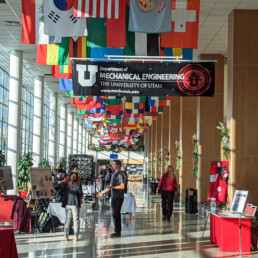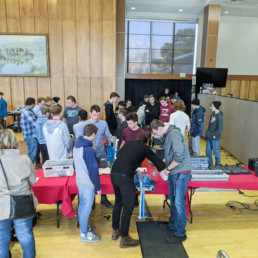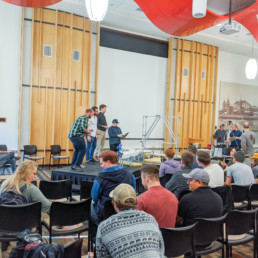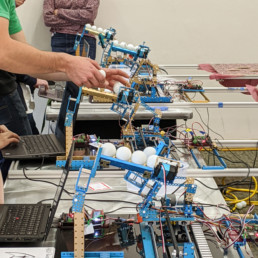Design Day - 2014
Design Day is an opportunity to share our Senior Design Showcase with the public. Seniors work in groups with faculty to design and test projects.
Additionally, freshman and junior mechatronics’ students compete and showcase their skills.
Senior Design Projects
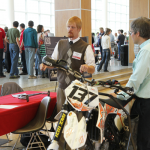 The goal of the Adaptive Motocross team is to design and manufacture a stability system for an off-road motorcycle. This system will be used by a paraplegic motocross rider to prevent the motorcycle from falling over when it is slowed or stopped. Because paraplegic individuals cannot prevent the motorcycle from tipping with their legs, another solution is needed. The system consists of two main components: a set of stability arms and a crash bar. The stability arms look much like bicycle training wheels, and can be raised or lowered by the rider at the push of a button to stabilize the motorcycle at will. The crash bar is simply a small steel tube that surrounds the legs of the rider. This crash bar was put in place to protect the rider’s legs should the motorcycle fall over, which is common in motocross. When complete, the stability system will allow a paraplegic individual to more safely enjoy the sport of motocross. (Adaptive Motocross Poster)
The goal of the Adaptive Motocross team is to design and manufacture a stability system for an off-road motorcycle. This system will be used by a paraplegic motocross rider to prevent the motorcycle from falling over when it is slowed or stopped. Because paraplegic individuals cannot prevent the motorcycle from tipping with their legs, another solution is needed. The system consists of two main components: a set of stability arms and a crash bar. The stability arms look much like bicycle training wheels, and can be raised or lowered by the rider at the push of a button to stabilize the motorcycle at will. The crash bar is simply a small steel tube that surrounds the legs of the rider. This crash bar was put in place to protect the rider’s legs should the motorcycle fall over, which is common in motocross. When complete, the stability system will allow a paraplegic individual to more safely enjoy the sport of motocross. (Adaptive Motocross Poster)
Team: Stephen Sauve (lead), Ryan Baguley, Sadee Hansen, Christian Holbert, Xabier Ovalle
Advisor: Dr. Andrew Merryweather
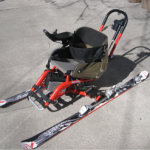 The purpose of the Tetra Ski project is to provide a venue for a person with tetraplegia (someone with limited or no control of their arms, legs, or torso) to experience snow skiing again, or for the first time, in a manner that provides the safety and exhilaration that a full-bodied person enjoys. The goal of the Tetra Ski is to take an alpine paraplegic sit-ski and modify it so that a person with tetraplegia can control it with whatever motor skills they have available to them.(Alpine Tetra Ski Poster)
The purpose of the Tetra Ski project is to provide a venue for a person with tetraplegia (someone with limited or no control of their arms, legs, or torso) to experience snow skiing again, or for the first time, in a manner that provides the safety and exhilaration that a full-bodied person enjoys. The goal of the Tetra Ski is to take an alpine paraplegic sit-ski and modify it so that a person with tetraplegia can control it with whatever motor skills they have available to them.(Alpine Tetra Ski Poster)
Team: Josh McCleary (lead), Daniel Blitch, David Landrith, Austin Matthews, Tyler Miller, Tyler Naegle, Kyle Richards
Advisor: Dr. Andrew Merryweather
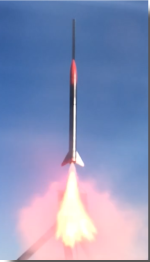 The atmospheric boundary layer research rocket team created a product to collect atmospheric data in a more efficient and cost effective way. The goals of the project were to: 1-design a rocket capable of reaching research height, 2-design a parachute that allows for incremental data measurement during descent, 3-build a sensor package to be resilient enough to withstand the forces associated with launch and recovery, 4-produce a sensor package that is capable of accurately measuring the required data, and 5-design a rocket to be aerodynamically stable. (Atmospheric Bounday Layer Research Rocket Poster)
The atmospheric boundary layer research rocket team created a product to collect atmospheric data in a more efficient and cost effective way. The goals of the project were to: 1-design a rocket capable of reaching research height, 2-design a parachute that allows for incremental data measurement during descent, 3-build a sensor package to be resilient enough to withstand the forces associated with launch and recovery, 4-produce a sensor package that is capable of accurately measuring the required data, and 5-design a rocket to be aerodynamically stable. (Atmospheric Bounday Layer Research Rocket Poster)
Team: Greg Woolston (lead), Jordan Van Dyke, Ulises Espinoza, Braeden Moore, Scott Schoen, Trevor Seguin
Advisor: Drs. Marc Calaf, Jed Marti and Rob Stoll
 The Utah Center for Advanced Imaging Research (UCAIR) at the University of Utah is developing a non-invasive method for treating breast cancer patients, known as magnetic resonance-guided high intensity focused ultrasound (MRgHIFU). The proposed project is to develop a system to cool the skin at the location where ultrasonic waves enter the tissue. This system must be compatible with current equipment and properly function within an MRI environment where strong magnetic fields exist. This project will enhance the efficiency of the procedure by preventing skin burns and protecting subcutaneous tissue. (Cancer Therapy Skin Cooling Poster)
The Utah Center for Advanced Imaging Research (UCAIR) at the University of Utah is developing a non-invasive method for treating breast cancer patients, known as magnetic resonance-guided high intensity focused ultrasound (MRgHIFU). The proposed project is to develop a system to cool the skin at the location where ultrasonic waves enter the tissue. This system must be compatible with current equipment and properly function within an MRI environment where strong magnetic fields exist. This project will enhance the efficiency of the procedure by preventing skin burns and protecting subcutaneous tissue. (Cancer Therapy Skin Cooling Poster)
Team: Duane Bywaters (lead), Anthony Alleman, David Chadburn, Drew Sparks
Advisors: Drs. Robert Roemer and Allison Payne
 The 2014 Formula SAE Aerodynamics team was created to improve the competitiveness of the University of Utah’s Formula SAE program. The main focus of the aerodynamics team is the generation of down force without adding needless weight. To do this, the use of a carbon fiber composite full body shell and rear spoiler will be designed and built to comply with the FSAE International competition. The implementation of an aerodynamics package to a formula style SAE race vehicle will increase traction at the tires, thus reducing lap times. (FSAE Aerodynamics Package Poster)
The 2014 Formula SAE Aerodynamics team was created to improve the competitiveness of the University of Utah’s Formula SAE program. The main focus of the aerodynamics team is the generation of down force without adding needless weight. To do this, the use of a carbon fiber composite full body shell and rear spoiler will be designed and built to comply with the FSAE International competition. The implementation of an aerodynamics package to a formula style SAE race vehicle will increase traction at the tires, thus reducing lap times. (FSAE Aerodynamics Package Poster)
Team: Nathan Jones (lead), Shaun Edwards, Sherif El Leithy, Kurt Schultz
Advisor: Dr. Kuan Chen
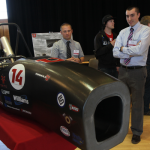 The University of Utah’s Formula SAE team is a collaborative effort of students with various skills and backgrounds contributing their time, talents and expertise towards a common goal. Domination of the miniature Formula One racing in FSAE! To accomplish this goal, our team decided to make a High Performance Carbon Fiber Monocoque to lower the weight of Formula U racing vehicle while also increasing the torsional stiffness of the chassis when compared to high strength chromoly steel.The goal was to lower the 0-60 time, decrease 60-0 distance, and increase the maximum g-forces.These goals will dramatically increase the performance of the Formula U vehicle and bring attention to the University of Utah Mechanical Engineering Department. (FSAE High Performance Composite Monocoque Poster)
The University of Utah’s Formula SAE team is a collaborative effort of students with various skills and backgrounds contributing their time, talents and expertise towards a common goal. Domination of the miniature Formula One racing in FSAE! To accomplish this goal, our team decided to make a High Performance Carbon Fiber Monocoque to lower the weight of Formula U racing vehicle while also increasing the torsional stiffness of the chassis when compared to high strength chromoly steel.The goal was to lower the 0-60 time, decrease 60-0 distance, and increase the maximum g-forces.These goals will dramatically increase the performance of the Formula U vehicle and bring attention to the University of Utah Mechanical Engineering Department. (FSAE High Performance Composite Monocoque Poster)
Team: Gabe Gray (lead), Jacob Anderson, Kirill Chernyavskliy, Adam Creer, Michael Harvey, Ben Mertlich, Jeet Singh
Advisors: Drs. Dan Adams and Samuel Drake
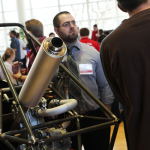 The objective of this project is to optimize the performance of a single-cylinder engine that meets the rules set forth by the Formula SAE annual competition. While there are numerous ways to enhance the performance of a racecar engine, this project focuses on the fluid dynamics of the intake and exhaust systems. This was accomplished by optimizing the design of the required restrictor, optimizing the propagation of pressure waves throughout the system, and using forced induction. The primary focus of the project is to accurately model the system using industry-standard software packages, and use the system model to optimize the design of the intake and exhaust piping to maximize performance. This includes optimizing both the length and geometry of the intake and exhaust piping as well as the selection of an appropriately sized turbocharger. (FSAE Performance Optimization of an Internal Combustion Engine Poster)
The objective of this project is to optimize the performance of a single-cylinder engine that meets the rules set forth by the Formula SAE annual competition. While there are numerous ways to enhance the performance of a racecar engine, this project focuses on the fluid dynamics of the intake and exhaust systems. This was accomplished by optimizing the design of the required restrictor, optimizing the propagation of pressure waves throughout the system, and using forced induction. The primary focus of the project is to accurately model the system using industry-standard software packages, and use the system model to optimize the design of the intake and exhaust piping to maximize performance. This includes optimizing both the length and geometry of the intake and exhaust piping as well as the selection of an appropriately sized turbocharger. (FSAE Performance Optimization of an Internal Combustion Engine Poster)
Team: Brett Sampson (lead), David Apgood, Cameron Blaylock, Joshua Crump, Aaron Jorgensen, Tyler Kolste
Advisor: Dr. Eric Pardyjak
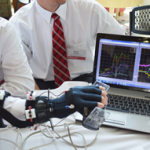 Our project is a grip force and wrist position measurement system. The primary objectives of the project are to create a system that outputs both the wrist position of a human test subject as well as the grip force at that position. This will be done using electrical sensors and a mechanical sleeve that will attach to the test subjects arm and hand. This device will be connected to a data recording software that will output the data and record the data to a computer. (Grip Force and Wrist Position Measurement System Poster)
Our project is a grip force and wrist position measurement system. The primary objectives of the project are to create a system that outputs both the wrist position of a human test subject as well as the grip force at that position. This will be done using electrical sensors and a mechanical sleeve that will attach to the test subjects arm and hand. This device will be connected to a data recording software that will output the data and record the data to a computer. (Grip Force and Wrist Position Measurement System Poster)
Team: Cory Seirup (lead), Chris Procter, Randy Schmutz
Advisor: Dr. Sanford Meek
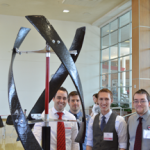 With the demand for greener sources of energy growing every day, the residential wind turbine is an answer to the individual’s pursuit for a greener home. Wind is a readily available resource, making it a viable, sustainable, and global energy source. The main focus for this project was a highly efficient blade design and a unique manufacturing process, assembly and material choice. (Helical Residential Wind Turbine Poster)
With the demand for greener sources of energy growing every day, the residential wind turbine is an answer to the individual’s pursuit for a greener home. Wind is a readily available resource, making it a viable, sustainable, and global energy source. The main focus for this project was a highly efficient blade design and a unique manufacturing process, assembly and material choice. (Helical Residential Wind Turbine Poster)
Team: Rex Ribelin (lead), Neal Crandall, Justin Lee, Robert Stevens
Advisor: Dr. Meredith Metzger
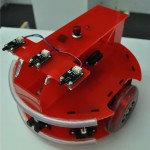 The Home Firefighting Robot competed in the Trinity College Fire-Fighting Robot competition held in Hartford, Connecticut in April 2014. The robot was designed to autonomously navigate through an eight-foot by eight-foot maze, locate a fire source, extinguish it, and return to its starting position. The robot competition is held on a yearly basis and is meant to help advance methods and technology for fighting fires in residential and industrial settings. (Home Firefighting Robot Poster)
The Home Firefighting Robot competed in the Trinity College Fire-Fighting Robot competition held in Hartford, Connecticut in April 2014. The robot was designed to autonomously navigate through an eight-foot by eight-foot maze, locate a fire source, extinguish it, and return to its starting position. The robot competition is held on a yearly basis and is meant to help advance methods and technology for fighting fires in residential and industrial settings. (Home Firefighting Robot Poster)
Team: Matt Ball (lead), Devon Crockett, TJ Park, Jen Sjoblom, JB Thiesset
Advisor: Dr. Stacy Morris Bamberg
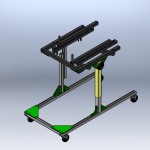 Neuroworx© is a nonprofit organization that offers rehabilitation to patients who have suffered spinal cord injuries. A key piece of equipment used in this rehabilitation process is a TheraGaitTM Gait Trainer. This gait trainer does not meet all the needs of therapists. The University of Utah improved rehabilitation walker uses lacks key functions needed by the Neuroworx© therapists in order to rehabilitate their patients. These functions include a single-sided height adjustment system, a bilateral adjustment system, movable grips, anti-scissor walking system, and a therapist seat. Based on the Solidworks simulations the material chosen performs to the desired specification to support a 300lb patient. (Improved Rehabilitation Walker Poster)
Neuroworx© is a nonprofit organization that offers rehabilitation to patients who have suffered spinal cord injuries. A key piece of equipment used in this rehabilitation process is a TheraGaitTM Gait Trainer. This gait trainer does not meet all the needs of therapists. The University of Utah improved rehabilitation walker uses lacks key functions needed by the Neuroworx© therapists in order to rehabilitate their patients. These functions include a single-sided height adjustment system, a bilateral adjustment system, movable grips, anti-scissor walking system, and a therapist seat. Based on the Solidworks simulations the material chosen performs to the desired specification to support a 300lb patient. (Improved Rehabilitation Walker Poster)
Team: Richard Rubel (lead), Miguel Alvarez, Jason Porter
Advisor: Dr. Donald Bloswick
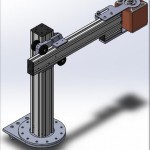 The challenge for the Omnimagnet team is to build a rigid framework to support multiple Omnimagnets. Omnimagnets are omnidirectional electromagnets consisting of three nested orthogonal solenoids with a spherical ferromagnetic core. They can be used for dipole-field generation and remote manipulation. It is useful to have multiple Omnimagnets working together to control a tool in 3-D space. In order for the Omnimagnets to function, the exact position and orientation of each Omnimagnet must be known. The Omnimagnet team must design and build a framwork that senses position and orientation of each Omnimagnet and then feed that information into the control program. (Omnimagnet Poster)
The challenge for the Omnimagnet team is to build a rigid framework to support multiple Omnimagnets. Omnimagnets are omnidirectional electromagnets consisting of three nested orthogonal solenoids with a spherical ferromagnetic core. They can be used for dipole-field generation and remote manipulation. It is useful to have multiple Omnimagnets working together to control a tool in 3-D space. In order for the Omnimagnets to function, the exact position and orientation of each Omnimagnet must be known. The Omnimagnet team must design and build a framwork that senses position and orientation of each Omnimagnet and then feed that information into the control program. (Omnimagnet Poster)
Team: Randy Neumann (lead), Trenton Prestwich, Jim Scoffield
Advisors: Dr. Jake Abbott, Andrew Petruska
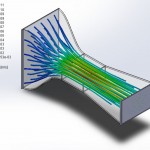 The main objective of the project was to design and build an economical and mobile wind tunnel that can be used in classrooms. Primary and secondary educators will use the wind tunnel to illustrate how fluids and particles move around canopies and objects, while giving students a hands-on learning experience. We hope to introduce new ideas to students and help excite them about learning, particularly in the fields of science and engineering. (Particle Flow Visualizer Poster)
The main objective of the project was to design and build an economical and mobile wind tunnel that can be used in classrooms. Primary and secondary educators will use the wind tunnel to illustrate how fluids and particles move around canopies and objects, while giving students a hands-on learning experience. We hope to introduce new ideas to students and help excite them about learning, particularly in the fields of science and engineering. (Particle Flow Visualizer Poster)
Team: Matt Moody (lead) Matt Sevier
Advisor: Dr. Rob Stoll
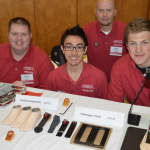 The increased growth rate in children means they must have their prosthesis replaced approximately every six months. This high rate of replacement means that cost to the customer is larger than the average adult prosthetic user. We designed a product that can be adjusted in length and energy return to compensate for the child’s growth. This will in turn mean the product can be worn for a longer period of time, thus dramatically cutting the cost. (Pediatric Prosthetic Poster)
The increased growth rate in children means they must have their prosthesis replaced approximately every six months. This high rate of replacement means that cost to the customer is larger than the average adult prosthetic user. We designed a product that can be adjusted in length and energy return to compensate for the child’s growth. This will in turn mean the product can be worn for a longer period of time, thus dramatically cutting the cost. (Pediatric Prosthetic Poster)
Team: Justin Smith (lead), Marcus Berry, Carter James, Jake Kunz, Justin Tsuyuki
Advisor: Dr. Donald Bloswick
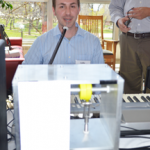 The Piano Pedal Activation product creates a means by which an individual with no lower extremity control may play the piano with the sustain pedal, the pedal most frequently used. The device will be portable, and compatible with any piano. The anticipated results from this project will be an inexpensive mechanism that will allow individuals with no lower extremity motor function to continue their hobby of playing the piano. (Piano Foot Pedal Activation System Poster)
The Piano Pedal Activation product creates a means by which an individual with no lower extremity control may play the piano with the sustain pedal, the pedal most frequently used. The device will be portable, and compatible with any piano. The anticipated results from this project will be an inexpensive mechanism that will allow individuals with no lower extremity motor function to continue their hobby of playing the piano. (Piano Foot Pedal Activation System Poster)
Team: Megan Welsh (lead), Brandon Cardon, Daniel Error, Jacob Harmer, Colby Johnson, Serei Panh
Advisor: Dr. Don Bloswick
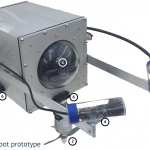 There is an extensive need for the development of a new method of operator-to-reactor communication and handling, as well as routine inspection and maintenance in research-level nuclear test reactors. This need will be addressed via a submersible radiation-resistant robot for use in a water-moderated reactor pool; the end-user will be the reactor operator. The solution will include streaming video, a variety of sensors, and full underwater mobility. The completion of this project will include a proof-of-concept working model of the robotic probe and a test of functionality in the University of Utah’s TRIGA Reactor. (Radioactive-Resistant Robot Poster)
There is an extensive need for the development of a new method of operator-to-reactor communication and handling, as well as routine inspection and maintenance in research-level nuclear test reactors. This need will be addressed via a submersible radiation-resistant robot for use in a water-moderated reactor pool; the end-user will be the reactor operator. The solution will include streaming video, a variety of sensors, and full underwater mobility. The completion of this project will include a proof-of-concept working model of the robotic probe and a test of functionality in the University of Utah’s TRIGA Reactor. (Radioactive-Resistant Robot Poster)
Team: Brooklyn Noble (lead), John Henrie, Richard Sisson, Nicklaus Traeden
Advisors: Ryan Schow, Drs. Tatjana Jevremovic, Bart Raeymaekers
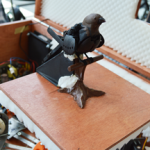 The mating habits of the Brown-headed Cowbird remain a mystery to ornithologists. Cowbirds are ‘brood parasites;’ meaning that the female cowbird lays eggs in the nests of other bird species and do not raise their own young. Once the young cowbirds are old enough, they will instinctively flock to other cowbirds to learn their courtship behavior. Some cowbirds are not able to find a flock soon enough to accurately learn the timing between the moves and the sounds of this mating dance. Dr. Goller from the Biology Department at the University of Utah is studying how well male brown-headed cowbirds communicate with their courtship behavior, which is suspected to be tied to the timing between the sounds and the motion. The uncertainty surrounding which aspects of the male cowbird’s mating routine result in successful mating provides the main reason for the construction of an animatronic bird. If our design is successful, researchers will be able to examine different aspects of the routine and determine what constitutes a suitable dance. (RoboBird Poster)
The mating habits of the Brown-headed Cowbird remain a mystery to ornithologists. Cowbirds are ‘brood parasites;’ meaning that the female cowbird lays eggs in the nests of other bird species and do not raise their own young. Once the young cowbirds are old enough, they will instinctively flock to other cowbirds to learn their courtship behavior. Some cowbirds are not able to find a flock soon enough to accurately learn the timing between the moves and the sounds of this mating dance. Dr. Goller from the Biology Department at the University of Utah is studying how well male brown-headed cowbirds communicate with their courtship behavior, which is suspected to be tied to the timing between the sounds and the motion. The uncertainty surrounding which aspects of the male cowbird’s mating routine result in successful mating provides the main reason for the construction of an animatronic bird. If our design is successful, researchers will be able to examine different aspects of the routine and determine what constitutes a suitable dance. (RoboBird Poster)
Team: Jon Stearn (lead), Abhijit Boppana, Ben Ferguson, Erik Halverson
Advisors: Drs. Robert Roemer, Franz Goller
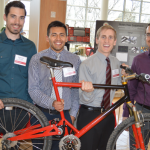 Typical rear suspensions require bulky linkages to be able to offer a measurable amount of travel from a linear spring and damper. This projects main target is to produce a product that offers more range of motion at a reduced weight than the current bicycle suspensions on the market. This will enable the rider to enjoy a smoother and easier ride. With this new style of suspension, the rider will be able to notice the added suspension travel and be able to move the bike around better because of the reduced weight in addition to a lower center of gravity. (Rotary Rear Suspension Poster)
Typical rear suspensions require bulky linkages to be able to offer a measurable amount of travel from a linear spring and damper. This projects main target is to produce a product that offers more range of motion at a reduced weight than the current bicycle suspensions on the market. This will enable the rider to enjoy a smoother and easier ride. With this new style of suspension, the rider will be able to notice the added suspension travel and be able to move the bike around better because of the reduced weight in addition to a lower center of gravity. (Rotary Rear Suspension Poster)
Team: Jameson Marshall (lead), James Oberlin, Jose Ortega, Wade Robins
Advisor: Dr. Meredith Metzger
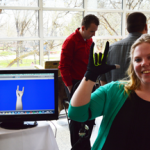 Sign Language is the predominant form of communication for the deaf communities. Signing is improved when the signed language is provided visually in training and practiced regularly. With the population of sign language users up to 500,000, it is meaningful to provide a technology that can enable them to effectively communicate and connect with other people. Our Sign Language Trainer is used to interpret a sign given by the user and translate it to text and voice in real time. Users wear a suit extending from the shoulder to the hands which is made of flex sensors and inertial measurement unit (IMU) sensors to determine position in 3D space during each moment of captured motion. Data is analyzed and used to write an algorithm that mapped a certain signed gesture to a certain word or phrase. (Sign Language Trainer Poster)
Sign Language is the predominant form of communication for the deaf communities. Signing is improved when the signed language is provided visually in training and practiced regularly. With the population of sign language users up to 500,000, it is meaningful to provide a technology that can enable them to effectively communicate and connect with other people. Our Sign Language Trainer is used to interpret a sign given by the user and translate it to text and voice in real time. Users wear a suit extending from the shoulder to the hands which is made of flex sensors and inertial measurement unit (IMU) sensors to determine position in 3D space during each moment of captured motion. Data is analyzed and used to write an algorithm that mapped a certain signed gesture to a certain word or phrase. (Sign Language Trainer Poster)
Team: Scott Larsen (lead), Bric Balmforth, Shawn Harris, Helen Ho, Lindy Jepsen, Giman Lee
Advisor: Dr. Andrew Merryweather
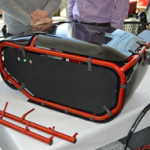 The objective is to build a gas-powered winch system that accelerates skiers and snowboarders up to a target velocity. The winch is designed to be safe, affordable, powerful, secure, portable, durable, and easily operated. We have observed that urban snowsports enthusiasts are frequently unable to obtain the speed necessary to utilize features in an urban environment that have a flat or limited in-run. This demographic, consisting of skiers and snowboarders, has improvised several methods to generate acceleration, many of which are unpredictable and potentially dangerous. Winches powered by small engines have been a recent innovation in this area, but none of the existing products are without serious drawbacks. These winch systems are often extremely heavy, prohibitively expensive, and inconvenient to operate. There is a considerable need in the current market for a winch system that is heavily tailored for affordable snowsports use. (Snow Sports Winch Poster)
The objective is to build a gas-powered winch system that accelerates skiers and snowboarders up to a target velocity. The winch is designed to be safe, affordable, powerful, secure, portable, durable, and easily operated. We have observed that urban snowsports enthusiasts are frequently unable to obtain the speed necessary to utilize features in an urban environment that have a flat or limited in-run. This demographic, consisting of skiers and snowboarders, has improvised several methods to generate acceleration, many of which are unpredictable and potentially dangerous. Winches powered by small engines have been a recent innovation in this area, but none of the existing products are without serious drawbacks. These winch systems are often extremely heavy, prohibitively expensive, and inconvenient to operate. There is a considerable need in the current market for a winch system that is heavily tailored for affordable snowsports use. (Snow Sports Winch Poster)
Team: Ross Imburgia (lead), Benjamin Bradshaw, Kyle Coxon, Spencer Dailey, Chris Dickson, Phillip Thompson
Advisor: Dr. Andrew Merryweather
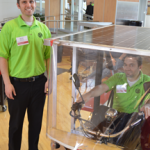 The project was to perform an assessment of the current vehicle and choose an engineering enhancement that would most greatly improve performance. The conclusion of the assessment was to implement regenerative braking by building a custom module that would give the desired regeneration along with hydraulic braking, and do so in a cost effective manner. The motors were also assessed to match the correct motor and motor curve for the performance expectations of the vehicle. The regenerative braking is the larger portion of the project, and requires most of the design effort. By adding these two modifications we expect to increase the range of the vehicle while also adding faster performance. (Solar-Powered Commuter Vehicle Poster)
The project was to perform an assessment of the current vehicle and choose an engineering enhancement that would most greatly improve performance. The conclusion of the assessment was to implement regenerative braking by building a custom module that would give the desired regeneration along with hydraulic braking, and do so in a cost effective manner. The motors were also assessed to match the correct motor and motor curve for the performance expectations of the vehicle. The regenerative braking is the larger portion of the project, and requires most of the design effort. By adding these two modifications we expect to increase the range of the vehicle while also adding faster performance. (Solar-Powered Commuter Vehicle Poster)
Team: Joe Strack (lead), Matt King, Brian Moote, Josh Sherwood, Zac Whatcott, Devin Williams
Advisor: Dr. Kent Udell
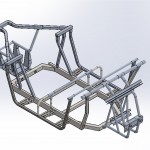 The goal of this project is to design and develop a new chassis for side-by-side off-road machines using the Polaris RZR 800 chassis as a proof of concept. The new chassis utilizes structural bonding methods in place of traditional welding used in assembly. This new method will make improvements over the current design including eliminating localized heat damage incurred during welding, allowing use of multiple materials in frame construction, and allowing for faster, simpler, and more cost-affective repairs. (Structurally Bonded Off-Road Chassis Poster)
The goal of this project is to design and develop a new chassis for side-by-side off-road machines using the Polaris RZR 800 chassis as a proof of concept. The new chassis utilizes structural bonding methods in place of traditional welding used in assembly. This new method will make improvements over the current design including eliminating localized heat damage incurred during welding, allowing use of multiple materials in frame construction, and allowing for faster, simpler, and more cost-affective repairs. (Structurally Bonded Off-Road Chassis Poster)
Team: Nick Child (lead), Matt Baker, Steve Bell, Todd McGraw, Chris Pell, Alex Welton
Advisor: Dr. Larry DeVries
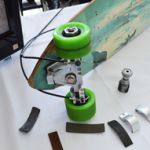 Design and build a braking device that attaches to a longboard for novice riders. This braking device will be actuated by a handle/cable that attaches to the brake while the rider holds the handle in their hand being able to apply the brake as needed.The system must allow for braking while turning and not interfere with the ‘feel’ of the ride. (Skateboard Brake Poster)
Design and build a braking device that attaches to a longboard for novice riders. This braking device will be actuated by a handle/cable that attaches to the brake while the rider holds the handle in their hand being able to apply the brake as needed.The system must allow for braking while turning and not interfere with the ‘feel’ of the ride. (Skateboard Brake Poster)
Team: Robert Murdock (lead), David Albert, Mike Johnson, Eric Sorenson
Advisor: Dr. Sanford Meek
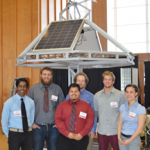 The objective of our project is to create a visually stunning and technically elegant installation art piece to donate to the University of Utah. It will take the form of a large kinetic sculpture that is powered through renewable sources of energy. The purpose of the project is to show the public that sustainability and engineering share many core principles. We hope to accomplish this by highlighting different forms of actuation: linear and rotational; and power them through renewable resources: solar and kinetic energy. Solar panels attached to a canopy structure will provide a majority of the power that the sculpture will use. Within the canopy will be rotating plates with intricate designs machined into them. The plates will create an interesting shadow display for the people underneath it. An elaborate four-bar linkage will be attached to the top of the canopy that will demonstrate the conversion of linear actuation into rotational through simple linkages and toggle points. Attached to the base of the piece will be a bench and/or a bike rack. This will give the sculpture added functionality in which to draw the public. A hand crank mechanism will be near the base of the sculpture that will supply energy by physically being turned by the public to a system of lights along the bottom of the canopy. The end result of our art piece will be an aesthetically pleasing sculpture, which will show impressive kinetics powered solely through sustainable resources. We hope this will spark interest in engineering as well as get the public to notice and appreciate eco-conscious design. (Sustainable Kinetic Sculpture Poster)
The objective of our project is to create a visually stunning and technically elegant installation art piece to donate to the University of Utah. It will take the form of a large kinetic sculpture that is powered through renewable sources of energy. The purpose of the project is to show the public that sustainability and engineering share many core principles. We hope to accomplish this by highlighting different forms of actuation: linear and rotational; and power them through renewable resources: solar and kinetic energy. Solar panels attached to a canopy structure will provide a majority of the power that the sculpture will use. Within the canopy will be rotating plates with intricate designs machined into them. The plates will create an interesting shadow display for the people underneath it. An elaborate four-bar linkage will be attached to the top of the canopy that will demonstrate the conversion of linear actuation into rotational through simple linkages and toggle points. Attached to the base of the piece will be a bench and/or a bike rack. This will give the sculpture added functionality in which to draw the public. A hand crank mechanism will be near the base of the sculpture that will supply energy by physically being turned by the public to a system of lights along the bottom of the canopy. The end result of our art piece will be an aesthetically pleasing sculpture, which will show impressive kinetics powered solely through sustainable resources. We hope this will spark interest in engineering as well as get the public to notice and appreciate eco-conscious design. (Sustainable Kinetic Sculpture Poster)
Team: Rajath Thekkedath (lead), Chris Aronitz, Zac Bensing, Sonoma Harris, Nikola Pehar, Christian Soto
Advisor: Dr. Kenneth Monson
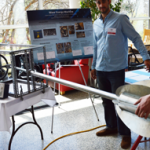 The wave energy machine is a machine that is to convert the continuous motion of waves into usable energy. The passing of waves across the ocean causes the fluid beneath the water surface to move in elliptical trajectories. As a result, there is a constant circular motion of the fluid as long as waves are present. The objective is to convert this circular motion to usable power. The wave energy machine is a submerged device that could be attached to the ocean floor or to a pre-existing offshore structure, such as an oil rig. By exploiting the near-endless amount of energy in the ocean, this alternative power source may decrease fossil fuel and coal use, thereby promoting continual progress in the reduction of carbon emissions. (Wave Energy Machine Poster)
The wave energy machine is a machine that is to convert the continuous motion of waves into usable energy. The passing of waves across the ocean causes the fluid beneath the water surface to move in elliptical trajectories. As a result, there is a constant circular motion of the fluid as long as waves are present. The objective is to convert this circular motion to usable power. The wave energy machine is a submerged device that could be attached to the ocean floor or to a pre-existing offshore structure, such as an oil rig. By exploiting the near-endless amount of energy in the ocean, this alternative power source may decrease fossil fuel and coal use, thereby promoting continual progress in the reduction of carbon emissions. (Wave Energy Machine Poster)
Team: Louise Butler (lead), Bilal Demir, Cale Lee, Joe Meiners, Christian Rodin
Advisor: Dr. Meredith Metzger
